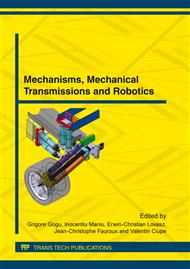[1]
O. D. Jefimenko, Electrostatic Motors -Their History, Types, and Principles of Operation-. Electret Scientific Company, (1973).
Google Scholar
[2]
J. U. Jeon and T. Higuch, Induction motors with electrostatic suspension, J. Electrost. 45 (1998) 157-173.
Google Scholar
[3]
R. Moser and T. Higuchi, Electrostatic rotation of glass disc, J. Electrost. 55 (2002) 97-108.
Google Scholar
[4]
F. Fuzesi, A. Jornod, P. Thomann, M. D. Plimmer, G. Dudle, R. Moser, L. Sache, and H. Bleuler, An electrostatic glass actuator for ultrahigh vacuum: A rotating light trap for continuous beams of laser-cooled atoms. Review of Scientic Instruments 78 (10) (2007).
DOI: 10.1063/1.2800777
Google Scholar
[5]
M. Dadkhah, Y. Hojjat, M. Modabberifar and T. Higuchi, Experimental investigation of parameters influencing electrostatic motor's performance with air bearing operation, Int. J. Adv. Manuf. Technol. 43 (2009) 211-216.
DOI: 10.1007/s00170-008-1710-3
Google Scholar
[6]
M. Modabberifar, A. Yamamoto and T. Higuchi, Modeling of an electrostatic induction actuator for dielectric sheet conveying, Sensors & Actuators A: Physical, 161 (2010) 271-277.
DOI: 10.1016/j.sna.2010.05.021
Google Scholar
[7]
S. Bart and J. Lang, Electroquasistatic induction micromotors, in Proc. IEEE MEMS (1989) 7-12.
Google Scholar
[8]
C. Livermore, A. R. Forte, T. Lyszczarz, S. D. Umans, A. A. Ayon and J. H. Lang, A high-power mems electric induction motor, J. MEMS. 13 (3) (2004) 465-471.
DOI: 10.1109/jmems.2004.828736
Google Scholar
[9]
S. Nagle, C. Livermore, L. Frechette, R. Ghodssi and J. Lang, An electric induction micromotor, J. MEMS. 14 (5) (2005) 1127-1143.
DOI: 10.1109/jmems.2005.851816
Google Scholar
[10]
F. J. Santana Martín, S. García-Alonso Montoya, J. M. Monzón Verona and J. A. Montiel-Nelson, Analysis and modeling of an electrostatic induction micromotor, in Proc. ICEM (2008) 1-5.
DOI: 10.3390/s101009102
Google Scholar
[11]
J.L. Steyn, S.H. Kendig, R. Khanna, S.D. Umans, J.H. Lang, and C. Livermore, A self-excited mems electro-quasi-static induction turbine generator, J. MEMS, 18 (2) (2009) 424-432.
DOI: 10.1109/jmems.2008.2011692
Google Scholar
[12]
B. Bollée, Electrostatic motors, Philips Tech. Rev. 30 (6/7) (1969) 178-194.
Google Scholar
[13]
C. Kooy, Torque on a resistive rotor in a quasi electrostatic rotating field, Appl. Scientif. Res. 20 (2-3) (1969) 161-172.
DOI: 10.1007/bf00382390
Google Scholar
[14]
J. Ubbink, Optimization of the rotor surface resistance of the asynchronous electrostatic motor, Appl. Scientif. Res. 22 (6) (1970) 442-448.
DOI: 10.1007/bf00400547
Google Scholar
[15]
S. D. Choi and D. A. Dunn, A surface-charge induction motor, in Proc. IEEE, 59 (5) (1971) 737-748.
DOI: 10.1109/proc.1971.8253
Google Scholar
[16]
E. R. Mognaschi and J. H. Calderwood, Asynchronous dielectric induction motor, Proc. IEE 137 (6) (1990) 331-338.
DOI: 10.1049/ip-a-2.1990.0051
Google Scholar
[17]
T. Hosobata, A. Yamamoto and T. Higuchi, An electrostatic induction motor utilizing electrical resonance for torque enhancement, Sensors & Actuators: A. Physical, 173 (2012) 180-189.
DOI: 10.1016/j.sna.2011.10.014
Google Scholar
[18]
T. Niino, T. Higuchi and S. Egawa, Dual excitation multiphase electrostatic drive, in: Proc. IEEE IAS 2 (1995) 1318-1325.
DOI: 10.1109/ias.1995.530454
Google Scholar
[19]
A. Yamamoto, T. Niino and T. Higuchi, Modeling and identification of an electrostatic motor, Precision Engineering 30 (1) (2006) 104-113.
DOI: 10.1016/j.precisioneng.2005.06.004
Google Scholar
[20]
A. Yamamoto, T. Niino, T. Ban and T. Higuchi, High-power electrostatic motor using skewed electrodes, Electr. Eng. Jpn. 125 (3) (1998) 50-58.
DOI: 10.1002/(sici)1520-6416(19981130)125:3<50::aid-eej6>3.0.co;2-r
Google Scholar


